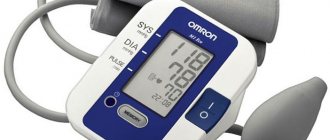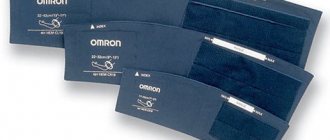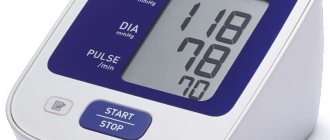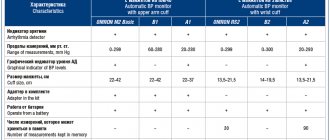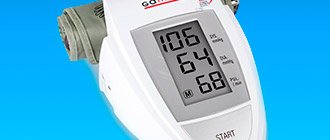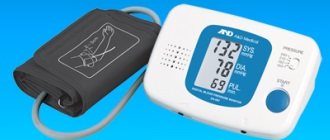Mercury tonometers, despite their “antiquity,” are still considered the most accurate mechanical devices for measuring blood pressure in medical institutions. The mercury meter is the oldest structural principle of sphygmomanometers, the predecessors of which were involved in both the measurement of blood pressure and the determination of the unit itself. One of the oldest mercury tonometers is Riva Rocci. Today it is classified as an antique, just like devices made in the USSR (collectors are willing to pay a lot of money for Soviet and foreign devices). More modern mercury tonometers are Diplomat presameter (Riester) and instruments from the manufacturer Bremed.
According to the instructions, the Diplomat presameter mercury tonometer is indicated as an accurate blood pressure meter. It is not inferior to Diplomat presameter and Bremed, the accuracy of which is considered to be quite high. Both devices are packaged in a convenient case.
The principle of a mercury tonometer
A mercury tonometer for measuring blood pressure is a tonometer consisting of the instrument itself and inflatable cuffs with a balloon and a valve. It is a bottle containing a small amount (several tens of milliliters) of mercury. This bottle is connected by a capillary to a measuring column, in which, due to atmospheric pressure, the default value is zero. When the pressure in the cuff increases, mercury is released from the bottle into the capillary, and the mercury column on the scale shows the current value of the pressure in the cuff. Both the cuff inlet connector and the measuring tube are separated by valves and filters so that spontaneous leakage of mercury does not occur. The measured scale usually has a range of up to 300 mmHg. Art., although even in severe conditions of hypertension there is no need to compress the cuff more than 250 mm Hg. Art.
Mechanical tonometers.
Compact and unpretentious , suitable for most users. The air pressure in the cuff is balanced not by a column of mercury, but by a sealed vessel with a flexible membrane. Depending on the bending of the membrane, the pressure gauge needle moves around the dial.
The tonometers are safe (do not contain mercury), compact, and weigh much less than mercury tonometers (the average weight of a mechanical Riester tonometer including a cuff is about 300 grams). High-quality tonometers are not sensitive to moderate mechanical influences - light shocks and shaking. However, compared to mercury tonometers, mechanical tonometers are less accurate - the flexible membrane is sensitive to changes in ambient temperature, and its sensitivity decreases over time. When using a metal membrane during operation, its elasticity decreases; with increased humidity, the membrane is subject to corrosion. The measuring mechanism of the tonometer does not like dust. Those. In order for measurements to be correct, it is necessary to regularly calibrate and clean the measuring mechanism.
To achieve maximum accuracy and extend service life, manufacturers come up with their own know-how. For example, in Riester tonometers:
- A copper-beryllium membrane is used (inexpensive tonometers from other manufacturers use a thin metal membrane). The copper-beryllium membrane does not lose elasticity over the years, does not react to changes in ambient temperature, has a double safety margin against excess pressure, and does not oxidize at high humidity. If you protect the device from rough physical influences, the tonometer will last a VERY long time!
- The air filter system prevents dust from penetrating into the tonometer housing.
- The release needle valve is made of particularly durable metal that does not wear out even with frequent use. This allows you to protect the tonometer from “air leaks”—spontaneous bleeding of air—for many years.
For additional protection of the measuring mechanism, a number of manufacturers offer tonometers in anti-shock design . Such models are not only intended for emergency services. The developers believe that even with normal use within the walls of the clinic, the tonometer will definitely be dropped several times a month. Depending on the height and angle of the fall, the calibration of the tonometer may be lost, so after each “injury” it is recommended to send the tonometer to a service center for verification. Shock-proof tonometers can withstand falls from a height of up to 1.2 meters (a guaranteed safe height to preserve the calibration), so this type of mechanical tonometer is recommended for intensive use outside the home.
Mechanical blood pressure monitors for self-measurements have some differences. As a rule, these models are equipped with a built-in stethoscope (the flat head of the stethoscope is built into the cuff). The cuff is equipped with a metal bracket to make it easier to wrap the Velcro around the forearm yourself.
Summary Mechanical blood pressure monitors are safe, compact and unpretentious. They will suit most practitioners and home users. However, when purchasing a tonometer, you should pay increased attention to the quality and accuracy of the measuring mechanism.
*****
Measurement
The instructions for using a mercury tonometer are simple. The measurement scheme is as follows:
- the patient exposes the arm on which the measurement will be taken, taking care that the sleeve does not compress it;
- a blood pressure cuff is placed at heart level;
- by using a balloon, the cuff is inflated enough to interrupt blood flow in the artery;
- the phonendoscope is applied to the elbow;
- pressing the balloon increases blood pressure values to approximately 140 mmHg. Art. (they are shown by the mercury column on the scale) - this stops the flow of blood through the arteries;
- the air from the cuff is then gradually released through the balloon valve.
Table of norm indicators
Each person, depending on many factors, develops his own working pressure, it is individual. The upper limit of normal is 135/85 mmHg. Art. The lower limit is 95/55 mm Hg. Art.
Blood pressure greatly depends on age, gender, height, weight, and the presence of diseases.
| Systolic pressure, mm Hg. Art. | Diastolic pressure, mm Hg. Art. | Age |
| 60–95 | 40–60 | up to 2 weeks |
| 85–115 | 55–70 | up to 3 years |
| 100–120 | 60–80 | 4–9 years |
| 110–130 | 65–80 | 10–15 years |
| 100–130 | 65–80 | 16–20 years old |
| 120–135 | 70–85 | 21–40 years old |
| 125–140 | 75–90 | 41–59 years old |
| 130–140 | 80–90 | over 60 years old |
Advantages
Reliable construction, simple design, accurate transmission of pressure in the cuff to the scale - thanks to these factors, even modern specialists use mercury tonometers. This measurement method provides more accurate results even with severe arrhythmia. Despite this fact, these devices are being eliminated from healthcare settings today due to the minimization of mercury used in healthcare. In addition, the complexity of repairs plays a role due to the frequent lack of necessary spare parts. After a breakdown, a mercury pressure meter is easier to dispose of. Most likely, in the near future, a mercury tonometer (USSR and other countries) will only be seen in photographs...
Important! Disposal of the device should only be carried out by specialists!
Which tonometer is better
The most suitable option for home use is an automatic shoulder tonometer.
It is quite accurate in measurements and does not require special skills for independent use. Modern models have a built-in memory function for one, two or three users with up to 150 measurements for each. You can save and compare measurement results, which replaces a self-monitoring diary. Any automatic tonometer is equipped with a visual indicator of the elbow crease. This allows the cuff sensor to be placed exactly where the artery pulsation is strongest. Air injection occurs automatically, according to a specific program, ensuring the pressure inside the cuff of the required force.
This is very important for older people suffering from hypertension. In some cases, such patients experience auscultatory gaps: zones of silence that are clearly distinguishable by auscultation of heart sounds.
If a mechanical tonometer is used by a person who is not aware of the possibility of such a pathology, he may miss the moment when the tones disappear (for example, at 110 with a real pressure of 200) and stop pumping air above 120–135 mmHg. This leads to false-normal readings at really high blood pressure.
Electronic tonometers have the function of additional air injection into the cuff and double control, which is very helpful in case of atrial fibrillation or auscultatory failure. Almost guarantees accurate detection of hypertensive crisis.
Advantages of MDF brand sphygmomanometers
The most accurate data is provided by a blood pressure meter - a sphygmomanometer when measuring large arteries: femoral or brachial. To carry out measuring manipulations using the MDF brand adult sphygmomanometer, no qualifications are required.
A high-precision medical sphygmomanometer determines and indicates signs of arrhythmia, arterial hypertension, and the device measures blood pressure in patients with an unstable heartbeat. For older people, doctors recommend an automatic tonometer-sphygmomanometer that is convenient and comfortable for home use. In offline mode, the device measures the heart pulsation rate, the pressure value after putting on the cuff, or pressing a button. The program displays the results on the screen of the blood pressure meter.
The competitively priced sphygmomanometer is distinguished by its functionality, since production involves equipping the device with auxiliary functions:
- pulse rhythm analysis;
- voice results for users with low vision;
- saving readings (data archive).
What was the prototype of the modern tonometer?
Soon after this, the prototype of the modern tonometer appeared. The device was created in 1881 by Samuel Z.K.R. von Basch, a doctor from Austria. His device worked like this:
- A hollow rubber bag filled with water was placed on the pulsating area of the artery;
- The sac pressed on the artery until the pulsation stopped completely;
- The strength of this pressure was measured with a mercury manometer;
- This indicator reflected systolic pressure.
Modern methods of measuring pressure appeared in 1896. Its author was the Italian S. Riva-Rocci, who invented a new device. In appearance, the device was similar to the tonometers that we use now. An empty rubber bag was inserted into a cuff made of non-stretch material. This structure was wrapped around the shoulder and connected to a pressure gauge. The cuff was pressurized through a special bulb.
As the pressure increased, the pulsation disappeared. After this, the pressure was relieved, and the pressure gauge reading at which pulsation resumed was considered the blood pressure level. True, the width of the cuff was only 5 cm, so it pinched the measurement area. Because of this, inaccuracies in the results arose. The problem was solved by Heinrich von Recklinghausen, who proposed using a 12 cm wide cuff.
Mercury tonometer is one of the first devices for measuring blood pressure. The device is structurally simple, consisting of a vertical glass tube through which a column of mercury moves under pressure. The glass pillar itself is marked in millimeters. This is why, traditionally, blood pressure is measured in millimeters of mercury. This measurement is considered very accurate and is used in various medical and scientific studies. Despite this, domestic use of this device is quite dangerous. This is due to a large amount of mercury, which can leak if the device is damaged. Therefore, the mercury column is placed in a metal or plastic case and is carried strictly in a vertical position. Currently, mercury tonometers are practically not used in everyday life.
A mechanical tonometer or aneroid is the next type of sphygmomanometer in the history of development. The device is a round digital scale marked from 0 to 300. Inside the body itself there is a mechanism that drives the digital scale arrow. Such tonometers are very common for home use. Their main disadvantage is that the pressure gauge is subject to frequent physical impact. Therefore, it must be checked regularly and handled carefully.
Mercury and mechanical tonometers themselves do not determine the level of blood pressure, they only show the level of air pressure in the cuff. Blood pressure is determined by a person using the Korotkoff sound method using a stethoscope. During the smooth deflation of air from the cuff over the pinched artery, pulsation sounds called Korotkoff sounds appear and then disappear. The reading on the pressure gauge at the moment the sounds appear means the level of systolic blood pressure, the reading at the moment the sounds disappear means the level of diastolic blood pressure. The Korotkoff method is the reference non-invasive method for measuring blood pressure, which is used to check blood pressure.
Semi-automatic brachial tonometer - consists of an electronic unit, a cuff and a pneumatic pump (bulb). Such tonometers determine pressure without human assistance, are usually not large in size and have only the simplest and most necessary functions. They consume little batteries and are capable of making more than 2000 measurements on a single battery charge.
Automatic shoulder blood pressure monitors are more complex in design, but the most convenient to use. In order to measure your blood pressure with this tonometer, you just need to correctly install the cuff on your arm and press the power button. Such a device will automatically measure your pressure and show the result. An automatic tonometer is the best choice for home use, since the “human factor” is reduced to a minimum, and additional indications and functions will help you monitor your blood pressure most effectively.
Automatic and semi-automatic electronic tonometers determine pressure without human intervention, by capturing short-term pressure surges in the cuff that occur at the moment the artery pulsates. This method of automatically measuring pressure is called oscillometric .
Automatic wrist tonometer is a compact tonometer that measures pressure on the wrist. In medical practice, measuring pressure at the wrist (radial artery) is not used due to lower measurement accuracy. This is due not only to possible cardiovascular diseases, but also to normal anatomical and physiological characteristics of the body. In the area of the wrist joint, the arteries are thinner, so the amplitude of the pulse wave is lower. A wrist tonometer is not suitable for those people whose pulse is weakly palpable, as well as for people over 40 and especially the elderly (over 60), since the walls of the arteries are no longer as elastic as at a young age: sclerosis (hardening) of the vessels occurs, therefore they begin to respond poorly to the pulse wave. As a result, the device may not detect or accurately detect a pressure surge in the cuff that occurs due to stretching of the artery.
First attempts to measure pressure
Even in Ancient Egypt, people knew how to feel the pulse, but the first experiments on measuring pressure were carried out only in 1773. It was then that the English research scientist Stefan Hales tried to determine the blood pressure of a horse. To do this he:
- He tied the left femoral artery of the animal with a rope;
- He made a puncture into which he inserted a copper tube connected to a test tube;
- When the rope was loosened, the blood in the test tube began to rise and fall simultaneously with the pulse beats.
Even with a stretch, such a device cannot be called the first tonometer. However, it was Hales’ technique that became the beginning of a new diagnostic direction in medical science.
The next significant event in this area occurred almost a hundred years later: the Frenchman Jean Louis Poisey measured pressure using a mercury manometer. The device was connected to a cannula inserted directly into the artery.
Advantages of automatic blood pressure monitors
automatic model appeared in 1965
device created by American therapist Seymour London. He replaced the stethoscope with a microphone that picked up tones, and instead of a rubber bulb, he used a compressor to build up pressure.
The new device initially caused some mistrust, so the scientist and his wife conducted a massive study. During the American Medical Association convention, 400 mechanical
and
automatic
methods. There were no significant differences in the obtained figures and Seymour received a patent for his invention.
Over time, the device has become very popular due to its many advantages:
- Ability to measure blood pressure without removing clothing;
- Maximum ease of use - to obtain accurate data, just put the cuff on correctly and press the button;
- The ability to simultaneously determine the pulse and identify the danger of arrhythmia;
- Saving measurement results in the device’s memory for subsequent study of dynamics;
- Displaying data on the screen.
An automatic tonometer allows you to easily and quickly measure blood pressure without the help of a stranger. The problem with a manual tonometer was the need to hear fairly quiet tones. Not everyone succeeds in this; it was especially difficult for older people. Automatic devices carry out all measurements themselves.
There is also a combination device that combines the features of automatic and manual. It has built-in memory and an electronic display that displays data on pressure and pulse. But for air injection there is a rubber bulb, which you need to squeeze yourself.
Over time, an additional modification of the automatic tonometer appeared. Its main difference lies in the method of fastening. Unlike classic models, in which the cuff is fixed on the shoulder, the device is attached to the wrist
. This is very convenient for people who lead an active lifestyle and do not want to be distracted from their work to take measurements.
Modern blood pressure monitors differ from their ancestors in their attractive appearance, variety of colors and models, practicality and ergonomics. There are modifications with large numbers that are clearly visible even with poor eyesight, with touch buttons, and powered by mains power or powerful batteries. They are easy and convenient to use; no special skills are required.
Another obvious advantage of current blood pressure measuring devices is synchronization with mobile applications. For example, there is a special HealthManager application that allows you to transfer the obtained measurement results to a synchronized smartphone.
The saved numbers can be viewed at any time, displayed in the form of a graph or table, entered into a diary of observations of your own condition, or printed before a visit to the doctor. The dynamics of indicators is important for diagnosing many diseases, and it is always easier for the user to notice changes with the help of visual graphics.
Several types of tonometers are used today:
- Shoulder - the Beurer BM 40 model has a cuff that is worn on the forearm. The device measures pressure, stores values, and calculates average morning and evening readings. The tonometer is able to detect arrhythmia and compare the obtained values with the norms. The large screen size makes it easy to distinguish numbers even for those who cannot boast of good eyesight;
- Wrist blood pressure monitors - model BC 57 allows you to get accurate results; Inflation technology is used to speed up the procedure. The device separately stores the indicators of two users, shows the risk level of arterial hypertension, transfers data to a smartphone or computer through the HealthManager application;
- Models with ECG function - the BM 95 tonometer from Beurer measures blood pressure through a cuff and records the ECG using an electrocardiograph, and also determines the pulse rate. The user receives data on pressure indicators and their compliance with standards, the presence of bradycardia or tachycardia, pauses in the cardiac cycle, and cardiac arrhythmias. The data is transferred to the Beurer CardioExpert smartphone application for subsequent analysis on a computer or smartphone.
Depending on your goals and situation, you can choose a suitable model and assess the state of your body without leaving your home.

